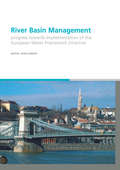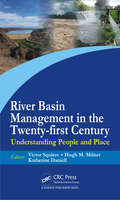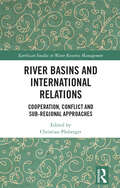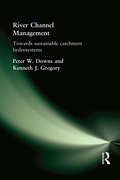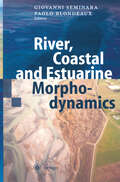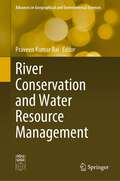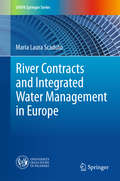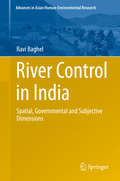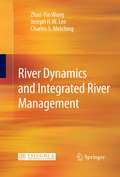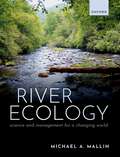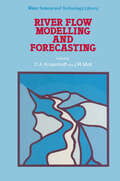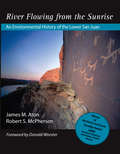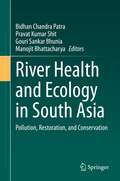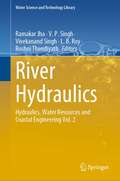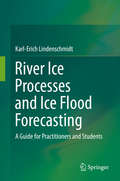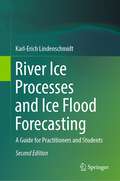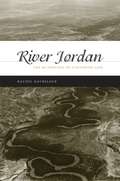- Table View
- List View
River Basin Management: Progress Towards Implementation of the European Water Framework Directive
by John LawsonRiver Basin Management is a collection of papers presented at a conference on implementation of the EU Water Framework Directive, held in Budapest in May 2005. The Water Framework Directive requires progressive protection and enhancement to rivers, lakes, estuaries, coastal waters and wetlands by the year 2015. At the heart of this major new piece of legislation is the requirement for all EU member states to prepare river basin management plans for all river basin catchments, providing the basis for coordinated improvements to water management, leading to better water quality and sustainable aquatic environments in lakes and rivers. The papers cover a wide range of topics including pilot studies for the development of river basin management plans, public participation in the planning process, water quality monitoring, modeling and analysis, identifying and addressing pollution and meeting environmental objectives. The book presents an array of experience from eighteen European countries in the implementation of the EU’s most far reaching environmental legislation. It is an invaluable source of information and ideas for the widespread preparation of river basin management plans now starting throughout Europe.
River Basin Management in the Twenty-First Century: Understanding People and Place
by Victor Roy Squires Hugh Martin Milner Katherine Anne DaniellWorldwide development of agriculture and industry creates burgeoning demands on natural resources. Management of the rivers and the surrounding landscape is one of the important tasks for today and for the foreseeable future. Lessons learned from centuries of management (and mismanagement) have been distilled into principles and practices which for
River Basins and International Relations: Cooperation, Conflict and Sub-Regional Approaches (Earthscan Studies in Water Resource Management)
by Christian PlobergerThis book argues that river basins represent a particular structural setting in international relations with the potential for generating a dynamic of cooperation among the involved countries. The volume applies the concept of regional cooperation to international river basins to highlight their relevance as a particular space in international relations, emphasizing both the inter-connectivity and transnationalism of international river basins. It addresses the challenges related to resource distribution between up- and down-stream countries, showcasing a variety of examples of cooperation and conflictual relations within various international river basins. Case studies are drawn from across the globe and include the Mekong, the Indus, the Euphrates-Tigris and the Danube international river basins. Each chapter outlines the different aspects which support or undermine cooperation in each case, taking into consideration key areas surrounding resource sharing, national development, environmental considerations and national security. This book will be of great interest to students and scholars with an interest in international river basins, regional cooperation, water resource competition, international relations and environmental politics.
River Basins and International Relations: Cooperation, Conflict and Sub-Regional Approaches (Earthscan Studies in Water Resource Management)
This book argues that river basins represent a particular structural setting in international relations with the potential for generating a dynamic of cooperation among the involved countries. The volume applies the concept of regional cooperation to international river basins to highlight their relevance as a particular space in international relations, emphasizing both the inter-connectivity and transnationalism of international river basins. It addresses the challenges related to resource distribution between up- and down-stream countries, showcasing a variety of examples of cooperation and conflictual relations within various international river basins. Case studies are drawn from across the globe and include the Mekong, the Indus, the Euphrates-Tigris and the Danube international river basins. Each chapter outlines the different aspects which support or undermine cooperation in each case, taking into consideration key areas surrounding resource sharing, national development, environmental considerations and national security. This book will be of great interest to students and scholars with an interest in international river basins, regional cooperation, water resource competition, international relations and environmental politics.
River Channel Management: Towards sustainable catchment hydrosystems
by Peter Downs Ken GregoryRiver Channel Management is the first book to deal comprehensively with recent revolutions in river channel management. It explores the multi-disciplinary nature of river channel management in relation to modern management techniques that bear the background of the entire drainage basin in mind, use channel restoration where appropriate, and are designed to be sustainable.River Channel Management is divided into five sections: ·The Introduction outlines the need for river channel management .·Retrospective Review offers an overview of twentieth century engineering methods and the ways that river channel systems operate. ·Realisation explains how greater understanding of river channel adjustments, channel hazards and river basin planning created a context for twenty-first century management.·Requirements for Management explains and examines environmental assessment, restoration-based approaches, and methods that work towards 'design with nature'·Final Revision speculates about prospects for twenty-first century river channel management. River Channel Management is written for higher-level undergraduates and for postgraduates in geography, ecology, engineering, planning, geology and environmental science, for professionals involved in river channel management, and for staff in environmental agencies.
River Channel Management: Towards sustainable catchment hydrosystems
by Peter Downs Ken GregoryRiver Channel Management is the first book to deal comprehensively with recent revolutions in river channel management. It explores the multi-disciplinary nature of river channel management in relation to modern management techniques that bear the background of the entire drainage basin in mind, use channel restoration where appropriate, and are designed to be sustainable.River Channel Management is divided into five sections: ·The Introduction outlines the need for river channel management .·Retrospective Review offers an overview of twentieth century engineering methods and the ways that river channel systems operate. ·Realisation explains how greater understanding of river channel adjustments, channel hazards and river basin planning created a context for twenty-first century management.·Requirements for Management explains and examines environmental assessment, restoration-based approaches, and methods that work towards 'design with nature'·Final Revision speculates about prospects for twenty-first century river channel management. River Channel Management is written for higher-level undergraduates and for postgraduates in geography, ecology, engineering, planning, geology and environmental science, for professionals involved in river channel management, and for staff in environmental agencies.
River Conservation and Water Resource Management (Advances in Geographical and Environmental Sciences)
by Praveen Kumar RaiThis book presents an up-to-date, systematic and scientific analysis of water resource problems in India and suggests measures to overcome them through effective water management. In addition, the book provides an overview of how changes in legislation, policies, institutional responsibilities, science, technology, practical techniques and public perception have influenced the ways of river management over the past years. River water conservation is a planned activity connected with various habitat features and outlines how to conserve all river water spread across the world. The restoration and conservation of river water must be of the highest priority for sustaining humanity and ecology for the present and future generations. In order to solve the water problems, conservation and recycling of water should be made mandatory for all domestic, industrial and agricultural projects. Apart from the priority to watershed development, rainwater harvesting and other appropriate conservation measures should be adopted to create awareness among the public so that their mind-set, attitudes and habits change proactively and they adopt sustainable practices rather than wait for legislation and regulations. The book augments the knowledge base of behaviour of rivers and evaluates the issues related to rivers so as to develop river system management techniques emerging from in-depth scientific analyses. It is useful for students, researchers, water resource managers, hydrologists and all those who are engaged or interested in any aspect of river water conservation and management of water resources in the country.
River Contracts and Integrated Water Management in Europe (UNIPA Springer Series)
by Maria Laura ScadutoThis book aims to stimulate new thinking on the roles of river contracts in the protection and management of hydrographic resources and ecosystems and in the sustainable development of dependent territories and communities. Up-to-date information is provided on a range of topics relating to river contracts, including their relevance to implementation of the EU Water Framework Directive on integrated river basin management. The importance of river contracts for innovation in territorial planning and governance is explored with the aid of comparative analysis between France and Italy that encompasses water management policies, legislative frameworks, contents and procedures, and stakeholder rules and participation. This analysis is supported by enlightening case studies in urbanized and rural contexts within the two countries. The book will be of high interest for all who wish to understand the potential of river contracts to create innovative forums for dialogue and knowledge sharing between public/private stakeholders and local communities and to prompt a new form of governance of river ecosystems and territories that is compliant with the subsidiarity principle.
River Control in India: Spatial, Governmental and Subjective Dimensions (Advances in Asian Human-Environmental Research)
by Ravi BaghelLarge river systems throughout the planet have been dramatically transformed due to river control projects such as large dams and embankments. Unlike other major human impacts like anthropogenic climate change, the alteration of river systems has been deliberate and planned by a small, powerful set of experts. Taking India as a case study, this book examines the way experts transform the planet through their discourse by their advocacy of river projects. This book identifies the spatial aspects of the norms through which the ideal river and the deficient river in need of control are produced. The role of governmental rationality in explaining the seemingly irrational and counter-productive effects of large projects like Kosi river embankments is considered. Finally using autobiographical material, the subjectivity of expert advice is examined, questioning its presumed objectivity. By examining the different subjective stances arising from the same body of expertise, this book discusses the consequences this has for river control specifically and for the relation between expertise and environmental change in general.
River Dynamics and Integrated River Management
by Zhao-Yin Wang Joseph H.W. Lee Charles S. Melching"River Dynamics and Integrated River Management” provides comprehensive information on rivers for integrated management, including natural processes, stresses resulting from human activities, and restoration of various parts of the river basin, including the watershed, mountain streams, alluvial rivers, estuaries, and natural and man-made lakes. Essential concepts, traditional and modern, such as river patterns, step-pool systems, vegetation-erosion charts, habitat diversity, and flushing times of bays, are clearly defined physically and explained with figures and pictures. Detailed mathematics and rigorous analyses are avoided so as to facilitate a holistic view of the subject of integrated river management. Researchers can easily familiarize themselves with the science of river management in its widest sense with the impressive pictures and examples in this book.Dr. Zhaoyin Wang is a professor at the Department of Hydraulic Engineering, Tsinghua University, China. Dr. Joseph H.W. Lee is a Chair Professor at the Department of Civil and Environmental Engineering, The Hong Kong University of Science & Technology, China. Dr. Charles S. Melching is a Professor at the College of Engineering, Marquette University, Milwaukee, WI, USA.
River Ecology: Science and Management for a Changing World
by Prof Michael A. MallinRivers have been vitally important to human populations worldwide for millennia as “highways” for inland travel, and as sources of water for drinking, cooking, cleaning, manufacturing, irrigation, and power generation, as well as repositories for human, animal, and industrial wastes. This accessible textbook takes a broad approach to river ecology, covering the basics but going beyond by including topics that are often overlooked such as blackwater streams and rivers, tidal creek ecosystems, and reservoir limnology. Since most running water (lotic) systems have been altered or impacted by human activities, there is significant emphasis on anthropogenic impacts, including sedimentation, nutrient pollution and related eutrophication issues as well as the effects of dams and river fragmentation, power plant operations, chemical contamination, wastewater treatment discharges, industrial scale livestock production, invasive species, and rural and urban storm water runoff on river ecosystems. Advances in stream and river restoration are also discussed.
River Flow Modelling and Forecasting (Water Science and Technology Library #3)
by D. A. Kraijenhoff J. R. MollAdvances in computer technology, in the technology of communication and in mathematical modelling of processes in the hydrological cycle have recently improved our potential to protect ourselves against damage through floods and droughts and to control quantities and qualities in our water systems. This development was demonstrated in a 1983 post-experience course at Wageningen University where an international group of experts reviewed successful modelling techniques and described the design and operation of a number of forecasting and control systems in drainage basins and river reaches of various sizes and under various geographical and climat ological conditions. A special effort was made to bridge the gap between theory and practice; case studies showed that each forecasting system was designed to meet a set of specific requirements and they illustrated that the forecasting system can only be expected to operate reliably if, on the one hand, it is based on sound theoretical concepts and methods and if, on the other hand, it is robust so that, also under adverse conditions, it will continue to collect and process the necessary input data and produce correct and timely signals. We were pleased to meet with encouragement for preserving the course material and making it available to a wider public. This was effected by the team of authorf who elaborated, updated and harmonized the materia in two stages; first into an issue of our university department and finally into the manuscript of this book.
River Flowing From The Sunrise: An Environmental History of the Lower San Juan
by James M Aton Robert McPhersonThe authors recount twelve millennia of history along the lower San Juan River, much of it the story of mostly unsuccessful human attempts to make a living from the river's arid and fickle environment. From the Anasazi to government dam builders, from Navajo to Mormon herders and farmers, from scientific explorers to busted miners, the San Juan has attracted more attention and fueled more hopes than such a remote, unpromising, and muddy stream would seem to merit.
River Health and Ecology in South Asia: Pollution, Restoration, and Conservation
by Bidhan Chandra Patra Pravat Kumar Shit Gouri Sankar Bhunia Manojit BhattacharyaThis volume reviews recent hydrological and environmental issues resulting from human-induced water pollution practices while providing case studies on the physical, chemical, and eco-biological techniques used to mitigate the impacts of river ecosystem pollution in South Asian countries. The book demonstrates the key methods of measurement, monitoring, mapping, and modeling of river water quality and how it is impacted by pollution and incorporates contemporary geospatial technological applications for the management and sustainability of future water resources. The major topics that the book addresses are the fundamental concepts of river ecosystem health, riverine ecology and habitats, risk assessment of riverine pollution, and technology-based river pollution control strategies. The book will serve as an interdisciplinary guide for researchers, students, and GIS specialists working in various disciplines, including pollution hazards, river ecosystem restoration, water quality, remote sensing, zoology, natural resources management, and environmental geography.
River Hydraulics: Hydraulics, Water Resources and Coastal Engineering Vol. 2 (Water Science and Technology Library #110)
by Ramakar Jha V. P. Singh Vivekanand Singh L. B. Roy Roshni ThendiyathThis book presents key principles of the hydraulics of river basins, with a unique focus on the interplay between stream flows and sediment transport. Addressing a number of basic topics related to the hydraulics of river systems, above all it emphasizes applicative aspects in order to provide the reader with a solid grasp of river engineering. The understanding of the river hydraulics is essential for the assessment of optimum locations for the conservation of water resources and its structures. This book will be interesting to readers and researchers working in the specialized area of river hydraulics of Ganga basin, Narmada, Tapi, Godavari, and other basins of India. It consists of review on hydraulics of meandering river; hydraulic design of reservoir in permeable pavement; optimization of hydraulic design; hydraulic investigations to optimize the design of spillway and design of energy dissipater; and analysis of performance of orifice spillway using computational fluid dynaics
River Ice Processes and Ice Flood Forecasting: A Guide for Practitioners and Students
by Karl-Erich LindenschmidtThis book exposes practitioners and students to the theory and application of river and lake ice processes to gain a better understanding of these processes for modelling and forecasting. It focuses on the following processes of the surface water ice: freeze-up, ice cover thickening, ice cover breakup and ice jamming. The reader will receive a fundamental understanding of the physical processes of each component and how they are applied in monitoring and modelling ice covers during the winter season and forecasting ice floods. Exercises accompany each component to reinforce the theoretical principles learned. These exercises will also expose the reader to different tools to process data, such a space-borne remote sensing imagery for ice cover classification. A thread supporting numerical modelling of river ice and lake ice processes runs through the book.
River Ice Processes and Ice Flood Forecasting: A Guide for Practitioners and Students
by Karl-Erich LindenschmidtThis book exposes practitioners and decision-makers to the theory and application of river ice processes to gain a better understanding of these processes for modelling and ice flood hazard and risk assessment. It focuses on the following processes of the surface water ice: river freeze-up and flooding, mid-winter ice-cover breakup and flooding and end-of-winter ice-cover breakup and ice jamming. The reader will receive a fundamental understanding of the physical processes of each component and how they are applied in monitoring, modelling and flood hazard/risk assessment of river ice during the entire winter season, from freeze-up to potential mid-winter breakup and concluding with springtime ice-cover breakup and ice-jam flooding. Spreadsheet, geographical information system (GIS) and modelling exercises accompany each component to reinforce the theoretical principles learned. Step-by-step tutorial videos allow the reader to better engage with the book and learn the material faster.
River in Flood Plain (large print)
by RnibThis page shows two images of a river valley, a plan view at the top and a cross section at the bottom of the page. There is a locator dot shown, which will be at the top left, when the image is the correct way up. Each image is surrounded by an image border. The image in the top of the page shows the river slowly winding its way along a wide valley. The valley is much wider than the river. The river goes from one side of the valley edge to the other and back again. The land rises on the left and right. A dashed line from A to B shows where the cross section is taken on the bottom image. The cross section image shows how flat the valley is. It is filled with alluvium (a fine muddy material sometimes called silt) that has built up from when the river floods and deposits mud and silt.
River in Flood Plain (UEB contracted)
by RnibThis page shows two images of a river valley, a plan view at the top and a cross section at the bottom of the page. There is a locator dot shown, which will be at the top left, when the image is the correct way up. Each image is surrounded by an image border. The image in the top of the page shows the river slowly winding its way along a wide valley. The valley is much wider than the river. The river goes from one side of the valley edge to the other and back again. The land rises on the left and right. A dashed line from A to B shows where the cross section is taken on the bottom image. The cross section image shows how flat the valley is. It is filled with alluvium (a fine muddy material sometimes called silt) that has built up from when the river floods and deposits mud and silt.
River in Flood Plain (UEB uncontracted)
by RnibThis page shows two images of a river valley, a plan view at the top and a cross section at the bottom of the page. There is a locator dot shown, which will be at the top left, when the image is the correct way up. Each image is surrounded by an image border. The image in the top of the page shows the river slowly winding its way along a wide valley. The valley is much wider than the river. The river goes from one side of the valley edge to the other and back again. The land rises on the left and right. A dashed line from A to B shows where the cross section is taken on the bottom image. The cross section image shows how flat the valley is. It is filled with alluvium (a fine muddy material sometimes called silt) that has built up from when the river floods and deposits mud and silt.
River Jordan: The Mythology of a Dividing Line
by Rachel HavrelockAs the site of several miracles in the Jewish and Christian traditions, the Jordan is one of the world’s holiest rivers. It is also the major political and symbolic border contested by Israelis and Palestinians. Combining biblical and folkloric studies with historical geography, Rachel Havrelock explores how the complex religious and mythological representations of the river have shaped the current conflict in the Middle East. Havrelock contends that the intractability of the Israeli-Palestinian conflict stems from the nationalist myths of the Hebrew Bible, where the Jordan is defined as a border of the Promised Land. Both Israelis and Palestinians claim the Jordan as a necessary boundary of an indivisible homeland. Examining the Hebrew Bible alongside ancient and modern maps of the Jordan, Havrelock chronicles the evolution of Israel’s borders based on nationalist myths while uncovering additional myths that envision Israel as a bi-national state. These other myths, she proposes, provide roadmaps for future political configurations of the nation. Ambitious and masterful in its scope, River Jordan brings a fresh, provocative perspective to the ongoing struggle in this violence-riddled region.
River Jordan: The Mythology of a Dividing Line
by Rachel HavrelockAs the site of several miracles in the Jewish and Christian traditions, the Jordan is one of the world’s holiest rivers. It is also the major political and symbolic border contested by Israelis and Palestinians. Combining biblical and folkloric studies with historical geography, Rachel Havrelock explores how the complex religious and mythological representations of the river have shaped the current conflict in the Middle East. Havrelock contends that the intractability of the Israeli-Palestinian conflict stems from the nationalist myths of the Hebrew Bible, where the Jordan is defined as a border of the Promised Land. Both Israelis and Palestinians claim the Jordan as a necessary boundary of an indivisible homeland. Examining the Hebrew Bible alongside ancient and modern maps of the Jordan, Havrelock chronicles the evolution of Israel’s borders based on nationalist myths while uncovering additional myths that envision Israel as a bi-national state. These other myths, she proposes, provide roadmaps for future political configurations of the nation. Ambitious and masterful in its scope, River Jordan brings a fresh, provocative perspective to the ongoing struggle in this violence-riddled region.
River Jordan: The Mythology of a Dividing Line
by Rachel HavrelockAs the site of several miracles in the Jewish and Christian traditions, the Jordan is one of the world’s holiest rivers. It is also the major political and symbolic border contested by Israelis and Palestinians. Combining biblical and folkloric studies with historical geography, Rachel Havrelock explores how the complex religious and mythological representations of the river have shaped the current conflict in the Middle East. Havrelock contends that the intractability of the Israeli-Palestinian conflict stems from the nationalist myths of the Hebrew Bible, where the Jordan is defined as a border of the Promised Land. Both Israelis and Palestinians claim the Jordan as a necessary boundary of an indivisible homeland. Examining the Hebrew Bible alongside ancient and modern maps of the Jordan, Havrelock chronicles the evolution of Israel’s borders based on nationalist myths while uncovering additional myths that envision Israel as a bi-national state. These other myths, she proposes, provide roadmaps for future political configurations of the nation. Ambitious and masterful in its scope, River Jordan brings a fresh, provocative perspective to the ongoing struggle in this violence-riddled region.
River Jordan: The Mythology of a Dividing Line
by Rachel HavrelockAs the site of several miracles in the Jewish and Christian traditions, the Jordan is one of the world’s holiest rivers. It is also the major political and symbolic border contested by Israelis and Palestinians. Combining biblical and folkloric studies with historical geography, Rachel Havrelock explores how the complex religious and mythological representations of the river have shaped the current conflict in the Middle East. Havrelock contends that the intractability of the Israeli-Palestinian conflict stems from the nationalist myths of the Hebrew Bible, where the Jordan is defined as a border of the Promised Land. Both Israelis and Palestinians claim the Jordan as a necessary boundary of an indivisible homeland. Examining the Hebrew Bible alongside ancient and modern maps of the Jordan, Havrelock chronicles the evolution of Israel’s borders based on nationalist myths while uncovering additional myths that envision Israel as a bi-national state. These other myths, she proposes, provide roadmaps for future political configurations of the nation. Ambitious and masterful in its scope, River Jordan brings a fresh, provocative perspective to the ongoing struggle in this violence-riddled region.
